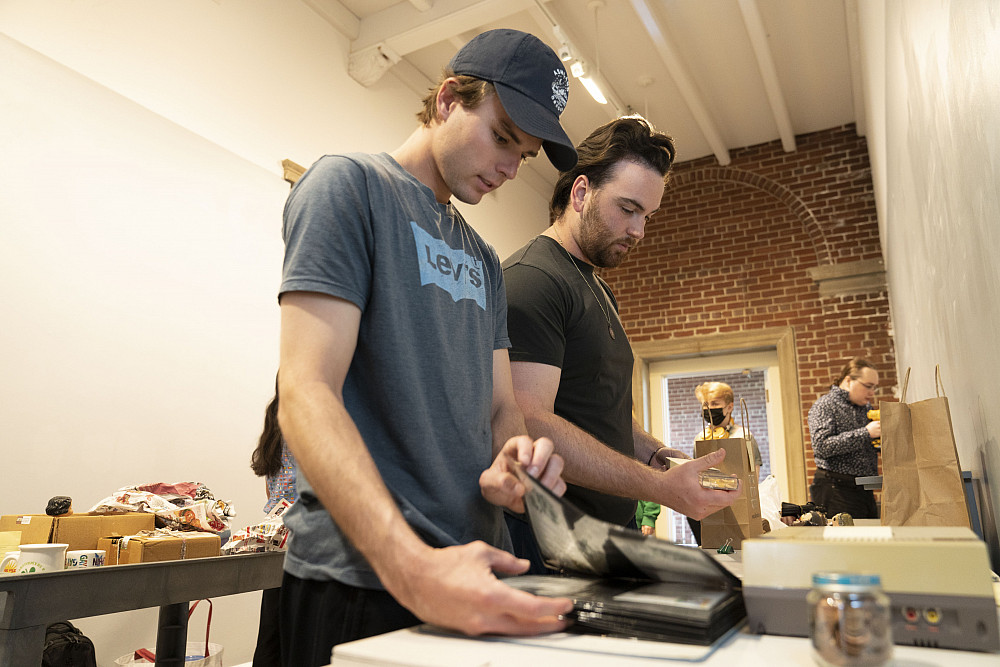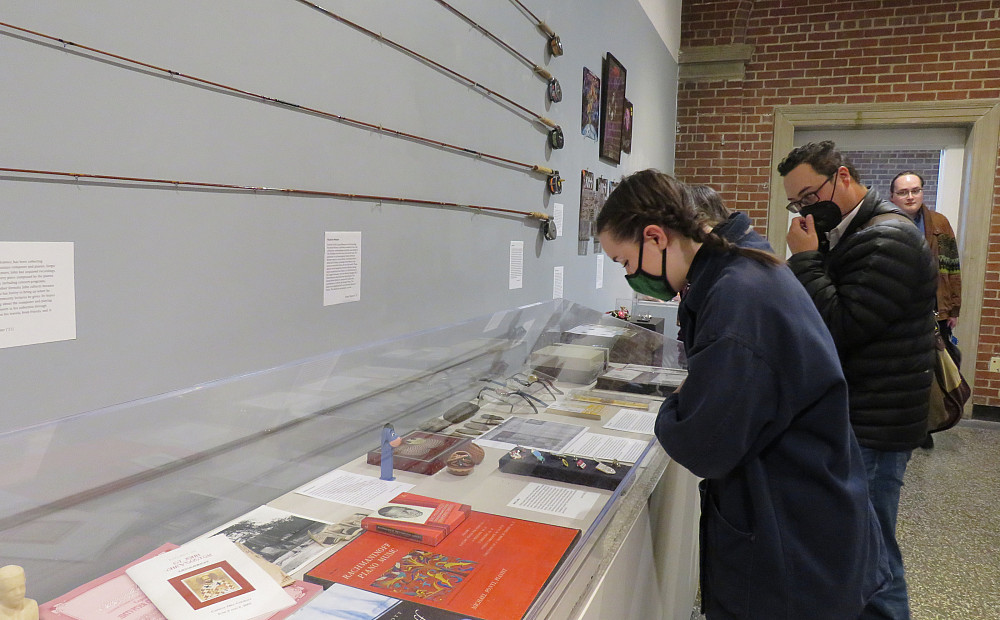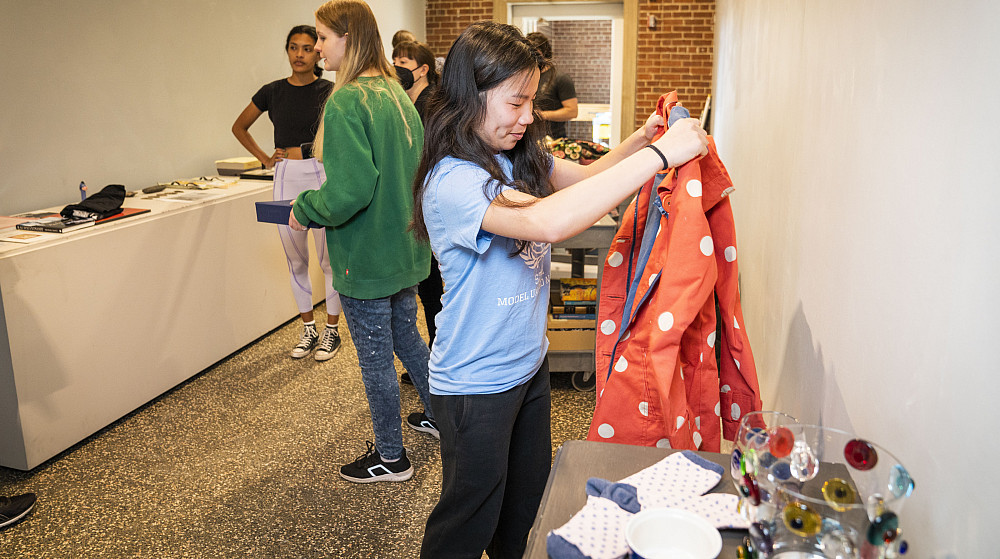Connecting Through Collecting
Like many unique and beloved Beloit courses, Collecting Stories: Objects and Their Owners began as a passion project. A decade and a half ago, Russian literature professor Donna Oliver began collecting postcards of pre-revolutionary Russian authors — particularly Leo Tolstoy, who was something of a celebrity in Russia’s late 19th- and early 20th-century postcard heyday.
Oliver, the Martha Peterson Professor for Distinguished Faculty Service, says that since she found her first postcards in a Moscow flea market, she has spent years acquiring different types of this niche postcard genre. She also expanded her collection to include pre-revolutionary ethnographic (and often exoticized) depictions of the peoples of the Russian empire.
As her collection grew, she began to use postcards and their history as sources for her scholarship, presenting several papers at conferences. These experiences inspired her to create a class in which students sourced collections from the campus community, learned about the collectors and their collections, then created something tangible: an exhibit in the Wright Museum of Art called “Beloit Collects! Connecting through Collecting.”
“[The course] comes from my interest in collecting and the desire to talk to people about collecting and share my own experiences,” she says. She hoped that her students — and the collectors they would interview — would learn from each other’s objects and stories.

Credit: Greg Anderson
In the course, students studied collecting as a phenomenon and grappled with the questions it raises about the past, memory, materiality, and authenticity. They explored the urge to collect and categorize, fetishize and possess, and considered the writings of cultural theorist Jean Baudrillard and many others.
In addition to conducting interviews with collectors, students participated in what Oliver calls “collective problem-solving” for the constantly evolving project. They organized how the exhibit would look and feel, what was displayed, and how the objects were talked about.
India Clizer’24, a collector of vintage gowns and other accessories that ended up being included in the exhibit, enrolled after she read the course description.
“I think what caught my interest was the idea that everybody — or at least most people — is a collector in some way, and that the objects we collect are somehow tied to our identity,” she says. “Those concepts got me thinking about myself and the people around me in a new light.”
Objects and their owners
At the beginning of the spring semester, Oliver’s class recruited nearly 40 interested faculty and staff members and students (including members of the Collecting Stories class, like India Clizer) to participate in the collection project. Students were each assigned two or three campus collectors and tasked with interviewing them and recording their stories — asking questions about their objects, how they were acquired, and why they were kept.
Oliver opened the class to students of all interests and all class years. Not surprisingly, museum studies and anthropology majors were drawn to enroll, but also students interested in history, sociology, creative writing, psychology — and the list goes on.
Being on both sides of the interview process excited Clizer. “I had to follow my curiosity and ask a lot of questions,” she says. “After thinking about all the different questions and angles I was taking with my participants, I tried to apply that same system to myself [while I was interviewed]. Pushing myself to answer the questions in the way I was asking my participants made me realize that the answers aren’t always there right away.” Participating in the “Beloit Collects!” exhibit encouraged Clizer and others “to think about the world — or even just yourself — a little differently.”
After the interviews, collectors gave students permission to borrow their precious objects to display in the exhibit.
Oliver introduced her students to the Wright Museum of Art and College Archives collections and enlisted Christa Story, the Wright Museum’s academic curator and interim director, and collections management intern Brooke McCammond’21 to help as students transformed an empty gallery into an exhibition space.

Credit: Greg Anderson
Creating an exhibit for the community lent itself to bringing people together after a prolonged absence of campus-wide events due to the pandemic. Oliver hoped that sharing stories and memories between members of different departments, age groups, and areas of expertise would strengthen relationships across campus.
“I thought it would be fun for people to experience their collected, treasured objects in a museum setting,” she says. The idea was that this experience would then elevate the perceived value of these collected items — not just as related objects, but as carefully curated collections.
That mindset was hard to break, even for some of Oliver’s own students, who didn’t think that their items constituted a collection, let alone belong in a museum.
“Initially, I expected that all the students collected,” she says. “The first day, several of them said they didn’t really collect anything. The more we talked, the more they started to think about their own objects as a collection of things that were of value to them.”
Items from exhibit participants were often more deeply connected to family, a particular time in their life, or their sense of self than to any monetary value. Every collection had a unique, personal story displayed alongside it, each one written by students from the Collecting Stories course.

Collections can also remind people of their personal and collective memories. Associate Professor of Spanish Amy Tibbits collects Depression-era glassware that conjures memories of spending time with her grandmother. Made in clear, pink, amber, and green, the glassware was affordable at a time when many households struggled to make ends meet, but it was elevated enough to make working-class families feel proud. Suzanne Healy’24 interviewed Tibbits about her glassware, which Tibbits began collecting with the help of her mother. She says she hopes to acquire enough pieces to populate her entire cupboard someday.
The collections varied in scale and type of object, too. Media studies major Alana Schacher’22 has dozens of rocks and crystals in her collection. She plans to acquire one of every type she can find and display them by color. Maxime Hall’23, an education and history double major from Germany, also participated as a collector and storyteller. Her large, diverse collections were narrowed to include giraffes, jewelry, and second-hand German novels. Political science professor Phil Chen owns 12 uniquely handcrafted fly-fishing poles made from bamboo that remind him of the life lessons of patience and observation that his father taught him.

Credit: Meg Kulikowski’21
Collecting stories
The more Oliver and her students investigated readings with what she calls a “critical, theoretical perspective,” the more they began to challenge preconceived notions of who is considered a collector and why. They realized that, contrary to stereotypes, collecting is not limited to eccentric art collectors and amateur archaeologists. As they interrogated theorist’s definitions, students began to advocate for a more inclusive approach: Anyone who collects something has the authority to decide its value.

Students’ efforts were realized when the exhibit opened in late April. Despite the hustle and bustle of the end-of-semester events, the exhibit’s opening gathered a sizable crowd of faculty, student, and staff collectors, along with their friends and colleagues. People were proud to see their own objects displayed. They exchanged family lore, historical anecdotes, and more than a few laughs — exactly the kind of connections Oliver had in mind when she created the exhibit and the course.
Meg Kulikowski’21 is a writer and editor in Beloit’s Communications and Marketing Office.
Exploring the collections
Finding Joy
Both Manger Professor of International Relations Beth Dougherty and Chief Communications Officer Elizabeth Conlisk say they hope to continue collecting objects that bring them joy.
Dougherty displays a collection of pigs — including figurines, like this green wooden pig she found in Galena, Illinois, as well as kitchen utensils and fabrics — in her home and office. She told her story to Alayna Furch’24.

Conlisk’s collection of polka-dotted items ranges from pillows and champagne flutes to wearable items, like sweaters and coats.

Credit: Greg Anderson
Whimsical Wind-Up Birds
Betsy Brewer, former director of the college’s international office, collects vibrant painted birds from around the world. Greer Simmons’22 interviewed Brewer and documented her collecting stories.

“They connect me to places where I’ve lived or been that I find meaningful,” Brewer says. In addition to her bird collection, Brewer also collects depictions of Russian cosmonaut Yuri Gagarin, vintage toy cars, and aprons, including a few intricately embroidered pieces from her years living in Slovakia.
Through Tough Times
Career Works’ Career Development Advisor Emily Sager has collected more than 130 angel figurines called Dreamsicles, only a fraction of which were displayed in the “Beloit Collects!” exhibit.
Sager received her first Dreamsicle — an angel perched next to a computer displaying the words “You’ve Got Mail” — from her parents when she was 16. She says the angels helped her get through a difficult time in her life. She has given some angels away to students and friends and hopes to pass the rest down to her daughter.

Credit: Greg Anderson


